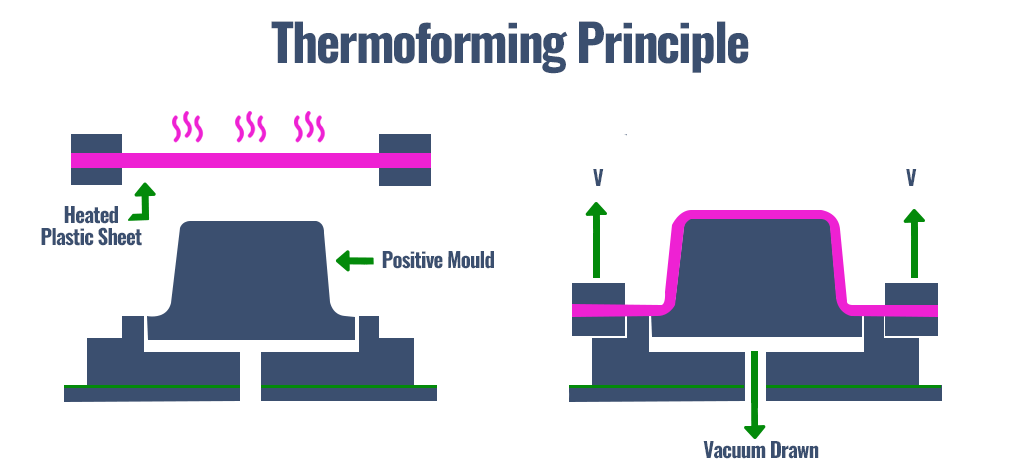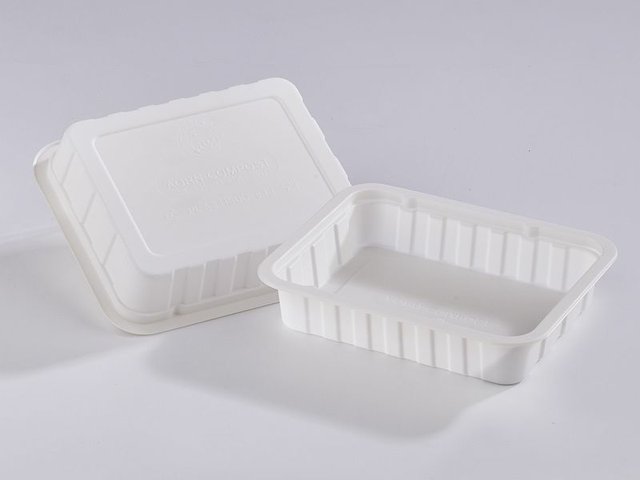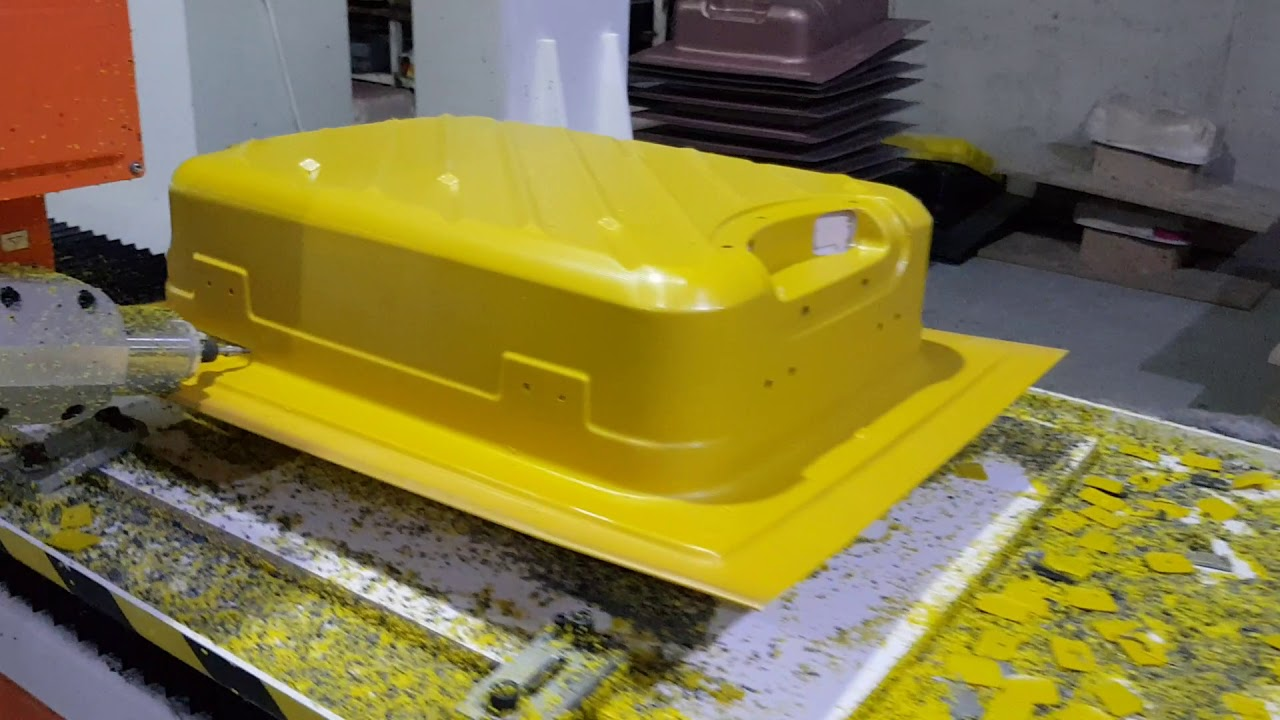Sep. 23, 2021
Thermoforming and vacuum forming work by drawing hot thermoplastic sheets around a mold. Next, any remaining air is sucked out to ensure consistent definition. The product is then taken off the mold and excess plastic is trimmed and recycled. Thermoforming is ideal for custom trays, packaging, panels and housings.

This fast and inexpensive technology requires less lead time and has lower tooling costs than injection molding or machining while also offering a lower part cost than 3D printing. Although thermoforming has some design limitations, it offers a wide variety of materials and provides excellent value for compatible projects such as 3D Printing for Prototyping.
Versatile Thermoplastics
Real thermoplastics are strong, durable and inexpensive compared to 3D printed materials. RapidMade offers an extensive range of thermoforming plastics, including PETG, HIPS, ABS, PC, Acrylic and many more, in thicknesses ranging from 0.020" to 0.250" (0.5 mm to .6.5 mm). With so many material options, thermoformed products are able to meet a host of mechanical and aesthetic demands, from conductivity and heat resistance to FDA food-grade certifications. Thermoformed parts can be rigid, flexible, translucent or opaque. This versatility lends itself to applications in a variety of industries, including food, medicine, electronics and manufacturing.
Thermoforming Design for Manufacturing (TFM DFM)
Thermoforming is an affordable technology for creating packaging, trays, panels, housings and more. These parts are durable, inexpensive and relatively quick to produce. Thermoformed parts can be rigid or flexible; opaque or translucent; and come in a variety of materials with different mechanical, thermal and chemical properties.
Although thermoforming has some design limitations and cannot achieve the fine detail of injection molding, machining or 3D printing, thermoforming offers lower startup costs than injection molding or machining and a lower cost per part than 3D printing, making it a good solution for small- to medium-sized orders.
How to Design Parts for Thermoforming
Because thermoformed parts are formed from a single sheet and need to be pulled off of a mold once formed, there are some specific design factors that must be considered when developing thermoformed parts. These include draw ratio, material thickness, draft angles and detail. When designing for thermoforming, it is also important to allow for shrinkage as the hot plastic cools. This will not only ensure that the finished parts have the desired dimensions, it will also allow the part to be lifted off of the mold without damaging the part or the tool.

1. Draft Angles
Because plastic sheets shrink when they cool, all thermoformed parts require some draft to ensure they can be removed from the mold. If the mold is of an internal cavity only, also known as a female mold, 2-5 degrees of draft is usually sufficient. If your mold includes raised features, it must have a minimum draft of 4-8 degrees to compensate for shrinkage during cooling. Small undercuts are possible with thinner plastics, however, larger undercuts or thicker materials will need to be made in multiple parts, leading to increased production time and expense.
2. Draw Ratio
When designing a part to be thermoformed, draw ratio, or the proportion of depth to the width of the part, is one of the most important considerations. The depth of any cavity cannot exceed a 4:3 ratio of depth to width. For optimal results, we recommend keeping as close to a 1:1 ratio as possible.
To find the overall draw ratio, divide the total surface area of the 3D part by the part’s 2D footprint as seen from the top. Though there are other details that determine design compatibility, draw ratio is a good place to start.
3. Size
Our thermoformers have bed sizes starting at 19” x 17” and a max draw depth beginning at 11.5 inches. Within these ranges we can also adjust forming windows to accommodate smaller sizes of 5” x 5”, 11” x 11” and 15” x 15” to reduce material costs for smaller parts. For larger parts, we can form up to 4’ x 8’, but this requires a custom vacuum box and sheet cut.
To determine the length and width of your window, we recommend adding your part’s height to both its length and width. For example, a part that measures 8” x 4” x 2” would need at least a 10” x 6” window.
4. Details and Mold Making
The highest amount of detail and dimensional accuracy will be on the mold side of the part and can achieve an accuracy similar to the accuracy of the tooling process. If dimensional accuracy on the other side of the sheet is important, expansion and contraction need to be taken into account for your chosen material and designed into the mold.
Thickness
Thermoplastic sheets come in a wide variety of thicknesses, ranging from 0.020” to 0.250”. When thinking about how thick of a sheet to use for your part, it’s often helpful to find the thinnest point of your part for each sheet. To do this, divide the sheet’s thickness by the draw ratio of the mold. This will give you an idea of the thinnest point for your part, though, in reality, it will vary above and below this.
The thinnest point will usually be at the corners of internal cavities, followed by the corners of ridges. To minimize thinning, we recommend keeping radii on corners and edges as large as possible, especially at the bottom of cavities and channels. As a general rule of thumb, parts should have a minimum fillet radius of ½ the material’s original thickness on the inside of the bend.
Male (Positive) vs Female (Negative) Molds
Male molds control the inside surface of a part while female molds control the outside surface of a part. The opposite surface is uncontrolled and can vary due to plastic thickness and thinning. Male molds tend to thin less than female mold but require more draft. Recommended draft for male molds is 4 degrees while for female molds it is only 2 degrees.
Common Issues that Can Occur when Thermoforming
Excessive thinning from high draw ratios and sharp corners. Try reducing draw or adding fillets to your design.
Webbing or bunching of material during draw. Spread features out more to allow plastic to stretch into recesses.
Plastic Shrinkage. Every plastic has a unique shrink rate. Calculate that shrink and adjust the mold size to accomodate.
Collapsible Tooling and Undercuts. These can be very tricky and require a great deal of experience. Please consult an expert.
| Thermoforming Tolerance Guidelines | ||
| ACTIVITY | TOLERANCE | GUIDELINE |
| FORMED MEASUREMENTS | +/-0.020” | Additional 0.001” per Inch beyond 12” |
| DRILLED HOLE DIAMETERS | +/-0.005” | Holes Equal or Lesser than 1” |
| DRILLED HOLE DIAMETERS | +/-0.010” | Holes from 1” to 5” |
| SLOTS | +/-0.010” | Slot Equal to or Lesser than 1” Any Direction |
| SLOTS | +/-0.020” | Slots Greater than 1” |
| 5 AXIS TRIM | +/-0.015” | Trim Features under 5” |
| 5 AXIS TRIM | +/-0.020” | Trim Features Greater than 5” |
Thermoforming Materials
Thermoforming materials like HIPS, PETG and ABS offer a range of mechanical, chemical and aesthetic properties. Thermoformed parts can rigid or flexible; transparent or opaque; and food-safe, heat-resistant, chemical-resistant, or UV-resistant. Below are our most commonly used materials for thermoforming. To get more information about any material, check out the included data sheet for all the specifications.

1. HIPS (Polystyrene)
Our most commonly-used material. Inexpensive, functional material that can be brittle at low temperatures and can off-gas at higher temperatures. Used for packaging trays, covers and light-duty structural pieces. Food-safe versions available.
2. PETG (Polyethylene Terephthalate) (Polyester)
Moderately inexpensive material with good water and oxygen barriers. Able to stand up to substantially lower temperatures than HIPS. Often used for food-safe applications, freezer packaging and water bottles.
3. ABS (Acrylonitrile Butadiene Styrene)
Medium-cost impact-resistant engineering plastic which can be flame retardant or UV resistant when blended with other materials. Used for high-end packaging and moderate-load structural components.
4. Kydex T (ABS/PVC) or Kydex 100 (Acrylic/PVC)
Expensive flame-retardant engineering plastic with high impact resistance. Used for moderate-load structures, covers and enclosures that require fire resistance. Kydex 100 is our go-to material for radomes.
5. PC (Polycarbonate)
Medium- to high-cost engineering plastic with high stiffness, impact strength and temperature resistance, plus options for UV and scratch resistance. Often used for glass replacements on phones, TVs, lights or glasses, as well as high-temp applications. Harder to form than most thermoplastics, especially for fine details.
6. PE, HDPE or LDPE (Polyethylene)
Moderately hard, inexpensive plastic with high chemical resistance. Does not off-gas at high temperatures. Chemical and thermal durability makes it well-suited for chemical-resistant containers. Higher shrink rate than other materials, which lowers tool life and increases variability between parts.
7. PP (Polypropylene)
Moderately-priced alternative to PE which improves thermal and mechanical properties. Higher level of chemical resistance than most plastics. Can be used as an engineering plastic. Used for chemical-resistant applications, including food contact.
8. PVC (Polyvinyl Chloride)
Hard engineering plastic with strong mechanical properties as well as high chemical and electrical resistance. Can be made rigid or flexible. Used for certain chemical-resistant containers.
9. Acrylic
An inexpensive, rigid and brittle plastic with relatively high UV resistance. More difficult to form than other plastics. Not intended for tight bends or details. UV resistance makes it well-suited to outdoor applications.
For more information or to discuss your fabrication project, please get in touch via our contact page or email us at info@idealrp.com
Previous: Steel or Stainless What is the Most Durable Sheet Metal?
Next: None
Search Blog

Thermoforming and Vacuum Forming
Sep. 23, 2021

Steel or Stainless What is the Most Durable Sheet Metal?
Sep. 23, 2021

8 Things You Need to Know About Anodizing Aluminum
Sep. 23, 2021

Sep. 08, 2021
Navigation
Resources
Contact Us
+86 0755 36957776
102, 41 block, No 67 Banggang Road, Dongfang Community, Songgang, Bao'an District, Shenzhen, China
Room 1508, Aran Center Office Seond Phase 15, Nathan Road 625, Kowloon, HongKong